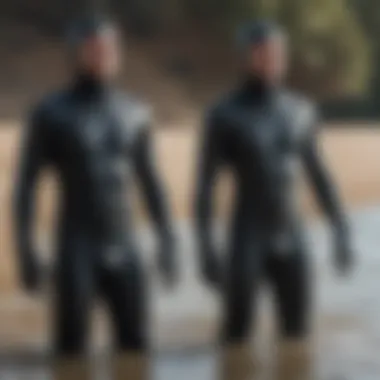Distinguishing Between Wet Suits and Dry Suits for Kitesurfing and Kiteboarding


Equipment Reviews
Travel Destinations
As kitesurfing and kiteboarding enthusiasts seek to maximize their experience, knowing the ideal travel destinations is paramount. Popular spots around the globe present diverse wind and water conditions for riders of all levels. Exploring off the beaten path destinations unveils hidden gems with unique atmospheres and challenges, allowing riders to expand their skills in uncharted waters. Comprehensive insights into each location's amenities and attractions further enrich the kitesurfing and kiteboarding journey.
Techniques and Tutorials
Mastering kitesurfing and kiteboarding involves a progression of skills, from beginner basics to advanced maneuvers. Step-by-step tutorials cater to novices, detailing fundamental techniques like launching, riding, turning, and landing. Advanced riders can delve into the intricacies of jumps, tricks, wave riding, and freestyle moves, enhancing their repertoire and style on the water. Whether you're starting out or aiming to push your limits, a comprehensive guide to techniques and tutorials is indispensable.
Safety Guidelines
Safety is paramount in kitesurfing and kiteboarding, with knowledge of weather conditions and emergency protocols being essential. Understanding how wind, currents, tides, and weather patterns impact safety equips riders to make informed decisions on the water. From outlining emergency procedures for mishaps to emphasizing equipment maintenance and inspections, a strong adherence to safety guidelines ensures a secure and enjoyable kitesurfing and kiteboarding experience.
Introduction
Kitesurfing and kiteboarding, two exhilarating water sports that attract thrill-seekers worldwide, rely significantly on the appropriate gear to maximize performance and safety. Among the essential equipment for these sports are wet suits and dry suits, pivotal in ensuring comfort and insulation against varying water temperatures. This article meticulously explores the differences between wet suits and dry suits in the context of kitesurfing and kiteboarding, aiming to provide enthusiasts with a comprehensive understanding of their distinct features, functionalities, and ideal usage scenarios.


Defining Wet Suits and Dry Suits
In the realm of kitesurfing and kiteboarding, wet suits and dry suits serve as vital components of the athlete's gear, each designed to cater to specific environmental conditions and performance needs. Wet suits are typically constructed from neoprene material, a flexible and insulating fabric that maintains warmth by trapping a thin layer of water against the skin, which the body then heats for insulation. Dry suits, on the other hand, are crafted from waterproof materials like Gore-Tex or similar fabrics, designed to keep the wearer completely dry by preventing water from entering the suit. This fundamental disparity in construction lays the foundation for their distinct functionalities and applications in water sports.
Distinguishing Features
During the thrilling adventures of kitesurfing and kiteboarding, the choice between wet suits and dry suits becomes pivotal. The distinguishing features of these suits play a crucial role in enhancing the experience and performance of extreme athletes. Firstly, focusing on material composition, wet suits are typically constructed from neoprene, a flexible and insulating material that offers comfort and freedom of movement. In contrast, dry suits are often made of breathable waterproof fabrics like Gore-Tex, providing superior waterproofing while maintaining breathability. Secondly, insulation properties vary significantly between wet and dry suits. Wet suits rely on the insulating layer of water trapped between the suit and the skin to maintain warmth, making them ideal for moderate to cold water temperatures. On the other hand, dry suits feature enhanced insulation through specialized lining materials or integrated thermal layers, ensuring warmth in even the coldest waters. Lastly, the water sealing mechanisms of these suits differ greatly. Wet suits utilize snug seals at the wrists, ankles, and neck to prevent water entry and provide a comfortable fit. Conversely, dry suits come equipped with waterproof zippers, neck and wrist seals, and integrated socks or booties to create a watertight barrier, keeping the wearer completely dry even in challenging conditions. Understanding these distinguishing features is essential for kitesurfers and kiteboarders to make informed decisions based on their unique needs and preferences.
Functionality in Water Sports
When delving into the world of kitesurfing and kiteboarding, understanding the functionality of the gear becomes paramount. Both wet suits and dry suits play crucial roles in enhancing the athlete's performance and ensuring safety while engaging in these exhilarating water sports.
Thermal Regulation
Thermal regulation stands as a cornerstone of importance when selecting the appropriate suit for kitesurfing and kiteboarding. The ability of the suit to keep the body at an optimal temperature despite external conditions is vital for comfort and endurance. Wet suits and dry suits differ significantly in their approach to thermal regulation, affecting the athlete's overall experience on the water.
Mobility and Flexibility


Beyond thermal considerations, the mobility and flexibility provided by a suit are essential factors for kitesurfers and kiteboarders. The range of motion a suit allows can impact performance greatly, affecting techniques and maneuvers executed on the waves. Finding a balance between insulation and freedom of movement is key to maximizing enjoyment and skill in these dynamic water sports.
Ideal Usage Scenarios
Ideal usage scenarios play a pivotal role in the realm of kitesurfing and kiteboarding. A critical aspect to consider when deciding between wet suits and dry suits, ideal usage scenarios revolve around optimizing performance and comfort in varying environmental conditions. For kitesurfing and kiteboarding enthusiasts, understanding the specific scenarios where each type of suit shines is paramount for an elevated experience out on the water.
Wet Suits: Optimal Conditions
When delving into the world of wet suits, one must acknowledge that they excel in specific conditions. Wet suits prove to be highly effective in scenarios where the water and air temperatures are not too extreme. Their design allows for insulation while still providing some degree of breathability, making them suitable for moderate climates. Kitesurfers and kiteboarders often find wet suits to be their go-to choice when engaging in these water sports in locations with temperate weather conditions.
Dry Suits: Specialized Situations
Contrastingly, dry suits cater to more specialized situations where the temperatures plummet, and water exposure becomes intense. These suits offer impeccable insulation and complete water sealing mechanisms, ensuring that the wearer remains dry and warm even in frigid waters. Dry suits are ideal for kitesurfing and kiteboarding aficionados braving harsh weather conditions or cold waters, providing unparalleled protection and comfort in extreme environments.
Comparative Analysis
In the realm of kitesurfing and kiteboarding, a thorough comparative analysis between wet suits and dry suits proves to be a pivotal aspect in ensuring optimal performance and comfort for enthusiasts. Understanding the distinct advantages and limitations of each type of suit empowers individuals to make informed decisions based on their specific needs and preferences. By delving into the intricate details of wet suits and dry suits, enthusiasts can tailor their gear choices to match the demands of varying water conditions and sporting preferences effectively.


Advantages of Wet Suits
Wet suits offer a myriad of advantages that cater to the dynamic needs of kitesurfers and kiteboarders alike. One of the primary benefits of wet suits lies in their exceptional flexibility, providing athletes with unrestrained movement during maneuvers on the water. Additionally, wet suits excel in thermal insulation, ensuring that individuals stay comfortably warm even in cold waters. The snug fit of wet suits not only enhances mobility but also reduces drag, thereby enhancing performance levels. Moreover, the durability of wet suits makes them ideal for regular use in moderate water temperatures, making them a versatile choice for a wide range of aquatic activities.
Advantages of Dry Suits
On the flip side, dry suits present a unique set of advantages that appeal to kitesurfers and kiteboarders confronting extreme water conditions. Unlike wet suits, dry suits are designed to provide complete waterproof protection, keeping individuals dry and insulated in frigid waters. This feature is especially beneficial for enthusiasts engaging in water sports during colder seasons or in icy waters. Dry suits also offer superior buoyancy, contributing to increased safety levels during emergencies or unexpected situations on the water. Additionally, dry suits can be customized with undergarments for added warmth, making them highly adaptable to a variety of environmental conditions. The impermeable nature of dry suits makes them a go-to choice for individuals seeking ultimate protection and comfort in the most challenging aquatic settings.
Maintenance and Care
In the realm of kitesurfing and kiteboarding, where the environment is harsh and unpredictable, Maintenance and Care play pivotal roles in enhancing both the longevity and performance of wet suits and dry suits. Neglecting these aspects could lead to premature deterioration, compromising safety and comfort during water sports activities. Therefore, understanding the intricacies of maintaining and caring for these specialized garments is crucial for enthusiasts and professionals alike.
When considering Maintenance and Care, several key elements must be taken into account to ensure optimal functionality and durability of wet suits and dry suits. Regular inspection for wear and tear, proper cleaning after each use, appropriate storage conditions, and timely repairs are among the fundamental aspects that cannot be overlooked. By adhering to a structured maintenance regimen, individuals can significantly extend the lifespan of their suits and maximize their performance capabilities in the water.
Moreover, the benefits of meticulous Maintenance and Care extend beyond mere upkeep of the suits. By investing time and effort into maintaining these essential pieces of gear, kitesurfers and kiteboarders can experience enhanced comfort, improved thermal insulation, and increased flexibility during their aquatic endeavors. A well-maintained suit not only ensures peak performance but also minimizes the risk of malfunctions or failures, providing a secure and enjoyable experience on the water.
In addition to the performance-related benefits, considering Maintenance and Care in a comprehensive manner fosters a sense of respect for the equipment and the sport itself. Treating wet suits and dry suits with care and attention reflects a conscientious approach to kitesurfing and kiteboarding, emphasizing the importance of safety, professionalism, and dedication to the craft. Therefore, integrating proper maintenance practices into one's routine transcends mere upkeep; it becomes a symbolic gesture of commitment to excellence and passion for the sport.
Conclusion
In the realm of kitesurfing and kiteboarding, the conclusion serves as a pivotal aspect that consolidates the essence of wet suits versus dry suits. Understanding the subtle discrepancies between these two types of suits can significantly impact the performance and comfort of enthusiasts partaking in these exhilarating watersports. The meticulous selection of either a wet suit or a dry suit can determine the athlete's agility, protection, and overall experience on the water. By deliberating on the advantages and disadvantages outlined in this article, individuals can make informed decisions that align with their specific needs and preferences, ultimately enhancing their kitesurfing or kiteboarding endeavors. Moreover, optimizing performance through suit selection is more than a mere investment in gear; it is an investment in comfort, safety, and efficiency, amplifying the joy and success derived from these thrilling aquatic activities.
Optimizing Performance through Suit Selection
When it comes to optimizing performance through suit selection, kitesurfers and extreme athletes must carefully consider various factors to ensure the ideal fit for their aquatic exploits. The choice between a wet suit and a dry suit goes beyond mere material preferences; it encompasses insulation requirements, water sealing mechanisms, and mobility constraints dictated by the specific demands of kitesurfing and kiteboarding. Understanding the distinct advantages of wet suits and dry suits enables practitioners to tailor their selection according to prevailing conditions and personal comfort levels. Dry suits, with their advanced waterproofing capabilities, are optimal for chilly waters or prolonged sessions, providing warmth and dryness to the wearer. On the other hand, wet suits, although less insulated, offer enhanced mobility and breathability, ideal for warmer environments or high-intensity riding. By delving into the nuanced differences elucidated in this guide, athletes can meticulously optimize their performance through strategic suit selection, elevating their overall experience and proficiency in kitesurfing and kiteboarding.







